Relevant to ACCA Qualification Paper P5 and Performance Objectives 12, 13 and 14
Andy Neely and Chris Adams describe their ‘Performance Prism’ as ‘a second generation performance management framework’. They claim that there are three major reasons why a new framework is needed to replace first generation models, such as the balanced scorecard and the performance pyramid:
Neely and Adams also believe that many organisations in recent years have become obsessed with measurement. Management are measuring too many things, in the belief that by doing so they must be controlling their organisations well. This trend has been confounded by the development of sophisticated IT systems that can provide a whole raft of reports to management.
The problem with this increase in measurement is that management start to micro-manage their organisations and lose sight of the strategic side of management. There is also the cost of providing the information, and the management time spent on it, compared to the questionable benefits that the measurement brings.
Management do not need more reports – they just need to know what is going on in the business. Measurement should be a process of gathering management information, not simply measuring everything.
The five facets of the prism
The Performance Prism aims to manage the performance of an organisation from five interrelated ‘facets’:
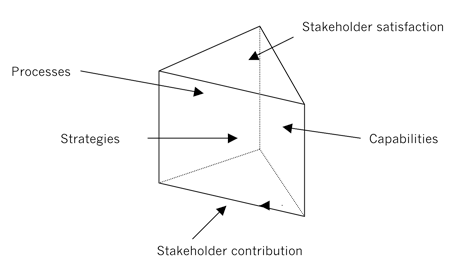
The Prism is designed to be a flexible tool – it can be used for commercial or non-profit organisations, big and small. When light is shined into a prism, it is refracted, thus the Prism shows the hidden complexity of white light. According to Neely and Adams, the Performance Prism illustrates the true complexity of performance measurement and management.
Stakeholder satisfaction
The first facet of the Prism focuses on who are the stakeholders, and what do they want. Here, the importance of stakeholder mapping is recognised. Stakeholder mapping means identifying the key stakeholders, and determining how important each of them are to the organisation. This may be based in how much power they have, and on whether or not they are likely to use it. If the majority of employees are members of a trade union, for example, then it is likely that the trade union will hold significant influence over the organisation.
If organisations do not keep the most influential stakeholder groups happy, then this will impact on financial performance in the long run. Dissatisfied employees, for example, will be less motivated or may leave the organisation, causing expenses of hiring and training new employees. Organisations need to identify the most important stakeholders, and what they want from the organisation. They must then identify performance measures to monitor how well the organisation is meeting these needs.
The major stakeholders of an organisation and what they might want typically are as follows:
Stakeholder contribution
Organisations are becoming more demanding in what they expect from their own stakeholders. In the second facet of the Performance Prism, users need to identify exactly what it is that the organisation wants from those stakeholders, and then come up with ways to measure whether or not the stakeholders are providing it.
A good example is customers. Many earlier performance measurement frameworks such as the balanced scorecard do ask ‘what do our customers want from us?’ They do not consider ‘what do we want from our customers?’ Organisations normally want loyalty and profits from their customers and many organisation s have started to perform customer profitability analysis. Some have found some surprising results – for example, customers whom they thought were their most valuable turned out to be loss making when activity-based approaches to customer profitability analysis were used. Customer profitability analysis is an example of how contribution from customers can be measured.
Regarding the other major stakeholder groups, the following are examples of what organisations might want from them:
Strategies
Many performance management frameworks start with strategy, and there is a myth that having identified the strategy of an organisation, selecting appropriate performance measures is easy. This is largely because many people confuse strategy and goals. In the Performance Prism, strategy means how the goal will be achieved. It is the route the organisation takes to reach the goal, not the goal itself. The goals are defined in the first two facets of the Prism.
In the strategies facet of the Performance Prism, therefore, we ask ‘what strategies should the organisation be adopting to ensure that the wants and needs of its stakeholders are satisfied, while ensuring that its own requirements are satisfied too?’
Having identified the appropriate strategies, performance measures will be identified that can be used to determine whether the selected strategies are working. The purpose of performance measures relating to strategies is four fold:
Processes
After identifying the strategies, organisations need to find out if they have the right business processes to support the strategies.
Many organisations classify four business processes as follows:
These processes can then be sub-divided into more detailed processes. Each process and sub process will have to have a process owner who is responsible for the functioning of that process. One sub process of ‘plan and manage the enterprise’, for example, might be ‘recruitment’, and it is likely that the head of human resources would be responsible for this process.
Measures will then be developed to see how well these processes are working. Management will have to identify which are the most important processes, and focus attention on these, rather than simply measuring the functioning of all processes. Business process reengineering may be used at this stage to identify any redundant processes. Value chain analysis may also be employed to identify what are the key processes. Value chain analysis is discussed in more detail later in this article.
Capabilities
Capabilities are the people, practices, technologies and infrastructure required to enable a process to work. It is important that the right capabilities exist within an organisation in order to support the processes identified in the processes facet of the Performance Prism.
Neely and Adams provide the example of an order to cash fulfilment process in an electronics business. This particular process may require the following capabilities:
In the capabilities facet of the Performance Prism, the organisation needs to identify which capabilities are required, and identify performance measures to see how well these capabilities are being performed.
Benchmarking is likely to be used extensively in measuring the organisation ’ s capabilities. In this respect, benchmarking is used to determine if the organisation has the right skills, not just currently, but also to take the organisation forward into the future. So the focus here is not in simply measuring existing performance, but that the correct skill sets exist. The McKinsey 7s model may also be used to help to ensure that all the capabilities of the organisation are coordinated. The 7s model is described in more detail later in this article.
The link between strategies, processes and capabilities
The facets of the Performance Prism are interlinked and should support each other. The required strategies are identified, then the processes required to achieve these strategies, followed by identifying the capabilities required to perform the processes. This is very much a top-down process, similar in some ways to the Lynch and Cross Performance Pyramid.
The most important development in the Performance Prism is the focus on identifying the needs of a wider range of stakeholders, as well as identifying what the organisation wants from its stakeholders in return.
Value chain analysis
Porter’ s value chain model is perhaps the most well-known tools for analysis of the value chain. The value chain views the organisation as a set of interlinked activities, rather than a set of separate departments. Each activity should add value to the product or service passing through it, so that ultimately value will be added to what the customer buys.
Porter identifies five primary activities and three support activities as shown in the diagram below:
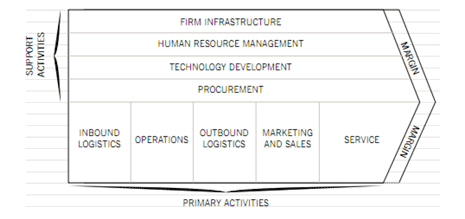
By viewing the organisation as a set of processes, management can plan ways to improve the processes so that further value can be added, or costs can be saved.
Process change can take place at different levels:
The value chain analysis can be used as a tool within the performance prism to help in the processes facet, where the management are asking ‘what are the processes that we have to put in place to meet our strategies?’
McKinsey’s 7s model
McKinsey ’s 7s model focuses on seven factors that must be considered and aligned when planning organisational change. The seven factors are divided into the ‘ hard factors ’ – those that can be easily influenced by management – and ‘soft factors’, which are more intangible.
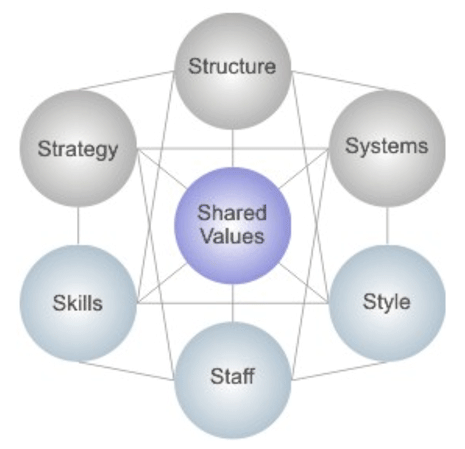
Hard factors
The hard factors are:
Soft factors
Equally important are the soft factors, which consist of:
The model can be used to identify what capabilities the organisation needs to perform its processes, and ultimately to meet its business strategy. As such, it can be a useful tool for using alongside the Performance Prism, when trying to ask the question ‘what capabilities do we need to imp rove our business processes?’
The Performance Prism in practice
Some well-known companies have used the Performance Prism . The most high-profile cases are the UK division of DHL, the international courier company, and House of Fraser, a British retailer. Following is a brief illustration of these.
DHL (UK)
The board of DHL (UK) was meeting monthly to review the performance of the business. There was increasing frustration that these meetings focused too much on detailed operational data, and that management were not obtaining the information required to manage the organisation more effectively at a strategic level.
During the year 2000, the board decided to replace the monthly performance meetings with a quarterly meeting during which a more strategic approach would be taken. They decided to adopt the Performance Prism as a framework for these meetings.
The process started with the identification of the wants and needs of the key stakeholders, and their contribution to the business. Particular strategies were developed for each of these stakeholder groups, followed by identifying what processes were required to support those strategies, and what capabilities were required to support the processes.
Having identified the strategies, processes and capabilities required the management then discussed which performance measures were necessary. It might be assumed that the organisation simply identified a list of performance measures for each strategy, process and capability identified. However, this was not the case. As Neely and Andrews say: ‘As an executive in a business, I do not necessarily want to know the minutiae of how many packages were delivered on time... I want information. I want answers to questions. The measures are merely a means of assessing data that allows me to answer questions.’
The directors asked themselves ‘what questions should we be asking at the quarterly performance review, which will enable us to assess whether our plans for the business as outlined... are being realised?’ These questions were then used to identify which measures might be appropriate to the organisation.
While detailed data on the performance measures identified in t he DHL ( UK ) case are not published, Neely and Adams do provide some examples of the questions the directors asked, and the appropriate performance measures relating to customers:
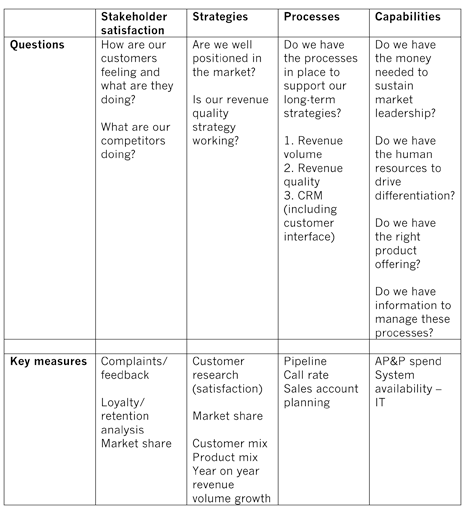
As a result of using the Performance Prism model, the directors of DHL (UK) believed that the quarterly performance review meetings became much more useful. The business process director commented: ‘We have moved from scrutinising lots of numbers that told us very little to asking pertinent questions about how we are doing and where we are going.’
The use of the Performance Prism helped management of DHL to really manage the business on a strategic level, and understand what was going on, so better decisions could be taken on how to improve performance.
London Youth
London Youth is a not-for-profit organisation that operates 460 youth clubs in London. Its mission is to assist the development of children and young people – in their physical, mental and spiritual capacities. It does this by organising educational and social activities for children. The organisation adopted the Performance Prism as a means of managing its performance.
The organisation identified its key stakeholders as being young people, youth workers and youth club management committees, London Youth staff and funders. Examples of some of the results of the analysis using the Performance Prism are as follows:
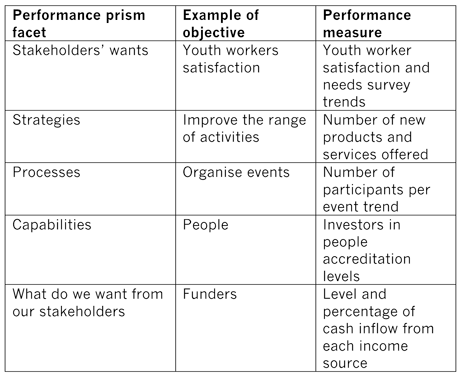
Finally a performance measure record sheet was developed for each measure selected. This documents the purpose, frequency of measurement and ownership of each measure. This is produced by both staff and management, with the advantage that staff will better understand the purpose of what they are being measured against and, therefore, are more motivated to try to achieve the targets.
Conclusion
The Performance Prism is a rigorous framework for assisting companies to manage their performance. Unlike older frameworks, it requires an analysis of stakeholders and their needs before considering strategy. It also considers what processes and capabilities are required to support the strategy before identifying appropriate performance measures. This should lead to performance at all levels of the organisation that is consistent with the strategy of the organisation, and help it to meet the needs of a wider group of stakeholders.
Nick Ryan is lead tutor for performance management subjects
References